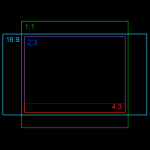Almost all the photos shown here on Darker View are cropped at a 2:3 ratio. The reason for this? I like it. And perhaps I am used to this ratio. It is very traditional, having been used for many applications for decades, including the venerable 35mm photographic film.

Any number of cameras produce images with a 2:3 ratio, including APS-C sensor DLSR’s like my Canon 60D. The ratio is by no means universal. Many cameras use a 4:3 ratio, most compacts do, including my Canon G12. Other ratios are popular, HD video is 16:9, spurring a rise in popularity of this wider format.
I have read a little about the choice in cropping, the argument regular rages in photographic circles. One article in particular got my attention, the author extolling the virtues of a square crop, a 1:1 ratio. Perhaps I am in a rut, and need to explore the use of other cropping ratios. I use 1:1 on occasion, usually for astrophotos. Perhaps I should experiment with other ratios more often.

